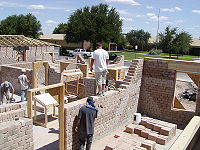
Photo from wikipedia
Abstract This study explores the coupling effect of pond ash (PA) and polypropylene (PP) fiber to control the strength and durability of expansive soil. The PA is used to chemically… Click to show full abstract
Abstract This study explores the coupling effect of pond ash (PA) and polypropylene (PP) fiber to control the strength and durability of expansive soil. The PA is used to chemically treat the expansive soil and PP fiber is adopted as reinforcement against tensile cracking. The sustainable use of PA and PP fiber are demonstrated by performing mechanical (i.e. unconfined compressive strength, split tensile strength and ultrasonic pulse velocity), chemical (pH value, electrical conductivity and calcite content), and microstructural analyses before and after 2nd, 4th, 6th, 8th and 10th freezing-thawing (F-T) cycles. Three curing methods with 7 d, 14 d and 28 d curing periods are considered to reinforce the 5%, 10%, 15% and 20% PA-stabilized expansive soil with 0.25%, 0.5% and 1% PP fiber. In order to develop predictive models for mechanical and durability parameters, the experimental data are processed utilizing artificial neural network (ANN), in association with the leave-one-out cross-validation (LOOCV) as a resampling method and three different activation functions. The mechanical and durability properties of the PA-stabilized expansive soil subgrades are increased with PP fiber reinforcement. The results of ANN modeling predict the mechanical properties perfectly, and the correlation coefficient (R) approaches up to 0.96.
Journal Title: Journal of rock mechanics and geotechnical engineering
Year Published: 2021
Link to full text (if available)
Share on Social Media: Sign Up to like & get
recommendations!